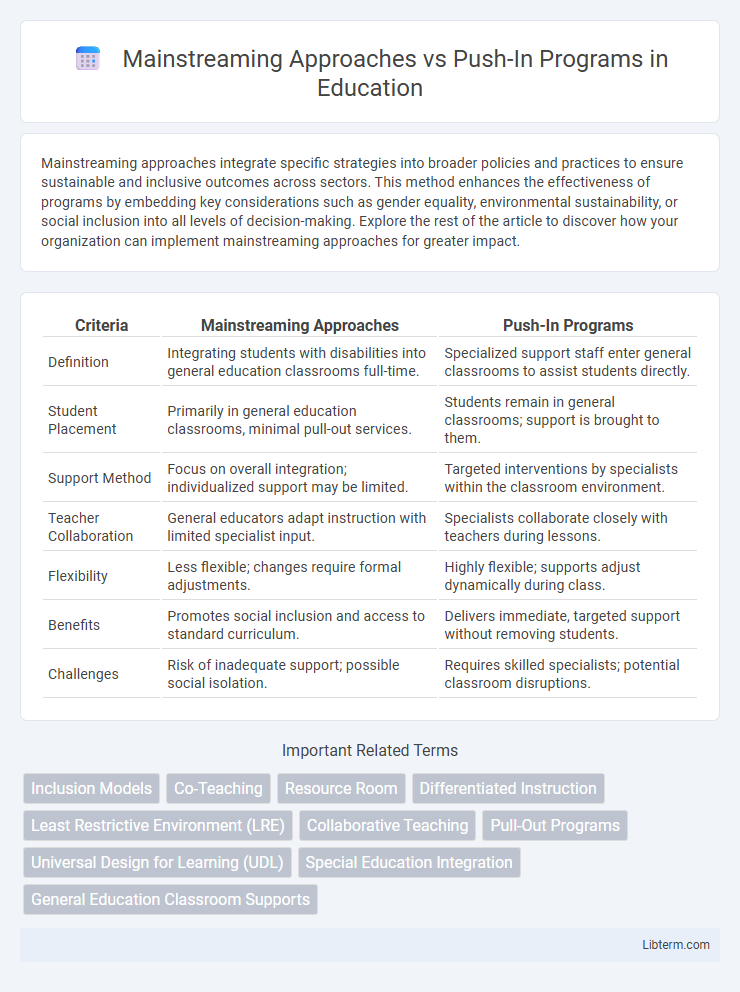Mainstreaming approaches integrate specific strategies into broader policies and practices to ensure sustainable and inclusive outcomes across sectors. This method enhances the effectiveness of programs by embedding key considerations such as gender equality, environmental sustainability, or social inclusion into all levels of decision-making. Explore the rest of the article to discover how your organization can implement mainstreaming approaches for greater impact.
Table of Comparison
| Criteria | Mainstreaming Approaches | Push-In Programs |
|---|---|---|
| Definition | Integrating students with disabilities into general education classrooms full-time. | Specialized support staff enter general classrooms to assist students directly. |
| Student Placement | Primarily in general education classrooms, minimal pull-out services. | Students remain in general classrooms; support is brought to them. |
| Support Method | Focus on overall integration; individualized support may be limited. | Targeted interventions by specialists within the classroom environment. |
| Teacher Collaboration | General educators adapt instruction with limited specialist input. | Specialists collaborate closely with teachers during lessons. |
| Flexibility | Less flexible; changes require formal adjustments. | Highly flexible; supports adjust dynamically during class. |
| Benefits | Promotes social inclusion and access to standard curriculum. | Delivers immediate, targeted support without removing students. |
| Challenges | Risk of inadequate support; possible social isolation. | Requires skilled specialists; potential classroom disruptions. |
Understanding Mainstreaming Approaches
Mainstreaming approaches integrate students with disabilities into general education classrooms for the majority or all of the school day, emphasizing inclusion while providing specialized support services as needed. These approaches promote social interaction and academic participation alongside peers, fostering a sense of belonging and enhanced learning opportunities. Effective mainstreaming requires collaboration between special and general education teachers to tailor instruction and accommodations to individual student needs.
Defining Push-In Programs
Push-in programs integrate specialized support services, such as special education or language assistance, directly into the general classroom environment, promoting inclusive education. These services are provided by specialists who collaborate with general education teachers to address diverse student needs without removing students from their main learning setting. Push-in approaches enhance accessibility and foster a collaborative teaching model, contrasting with separate, pull-out resource sessions.
Key Differences Between Mainstreaming and Push-In
Mainstreaming involves placing special education students in general education classrooms with minimal support, emphasizing integration while maintaining standard classroom dynamics. Push-in programs incorporate specialized educators who provide targeted assistance within the general classroom, ensuring tailored support without removing students from the setting. Key differences include the level of direct support and collaboration between general and special educators, with push-in models offering more intensive, in-class intervention compared to the broader inclusion goal of mainstreaming.
Benefits of Mainstreaming Approaches
Mainstreaming approaches enhance social integration by placing students with special needs in general education classrooms, fostering peer interaction and reducing stigmatization. These approaches provide access to the same curriculum and high academic expectations as their typically developing peers, promoting equitable learning opportunities. Research indicates that mainstreaming supports improved communication skills and greater independence for students with disabilities compared to segregated push-in programs.
Advantages of Push-In Programs
Push-in programs enhance inclusive education by integrating specialized support within the general classroom, promoting social interaction and reducing stigma for students with disabilities. These programs allow for real-time collaboration between general and special educators, improving individualized instruction and addressing diverse learning needs more effectively. Push-in models also foster a sense of belonging and equality by enabling all students to participate in the same academic environment.
Challenges Faced in Mainstreaming
Mainstreaming approaches face significant challenges such as inadequate teacher training, limited classroom resources, and insufficient support for students with special needs. Inclusive classrooms may struggle with maintaining an appropriate curriculum pace while addressing diverse learning abilities, often leading to student disengagement or unmet educational goals. Furthermore, systemic barriers like large class sizes and lack of collaboration between special educators and general teachers hinder effective implementation of mainstreaming.
Obstacles of Push-In Implementation
Push-in programs face obstacles such as limited classroom space and insufficient teacher training, which hinder effective collaboration between general and special education staff. Scheduling conflicts and high student-to-teacher ratios often reduce individualized support for students with disabilities. Resistance from educators unfamiliar with inclusive teaching methods further complicates the seamless integration of push-in services.
Impact on Student Outcomes
Mainstreaming approaches integrate students with disabilities into general education classrooms for most of their day, promoting social inclusion and access to grade-level content, which often leads to improved academic performance and self-esteem. Push-in programs involve specialists or support staff entering the general education classroom to provide targeted assistance, resulting in more personalized support without removing students from the core learning environment, enhancing both engagement and comprehension. Studies indicate that both approaches positively impact student outcomes, but their effectiveness depends on factors like the level of support, teacher collaboration, and individual student needs.
Teacher Roles in Both Models
Teacher roles in mainstreaming approaches emphasize modifying curriculum and instruction to meet diverse learner needs within general education classrooms, requiring strong collaboration with special educators. In push-in programs, teachers maintain their primary responsibility for instruction while special educators provide targeted support directly in the classroom, fostering co-teaching dynamics. Both models demand adaptive teaching strategies and continuous communication to ensure effective inclusion and individualized student support.
Selecting the Best Approach for Diverse Classrooms
Selecting the best approach for diverse classrooms depends on student needs, teacher expertise, and available resources. Mainstreaming approaches place students with disabilities in general education settings with minimal support, promoting social integration but requiring strong differentiation strategies. Push-in programs embed specialized support within the classroom, enhancing individualized instruction while maintaining inclusion and collaboration among educators, leading to improved learning outcomes.
Mainstreaming Approaches Infographic

 libterm.com
libterm.com